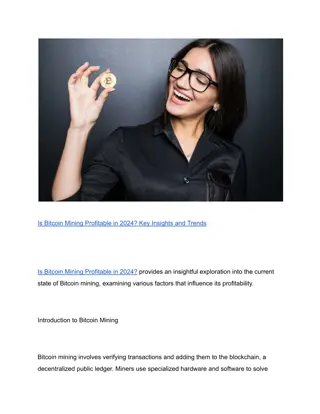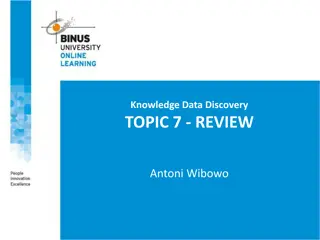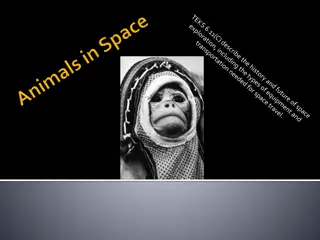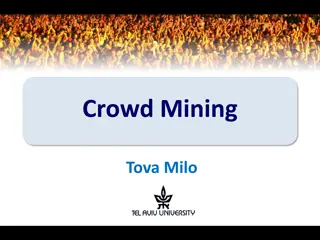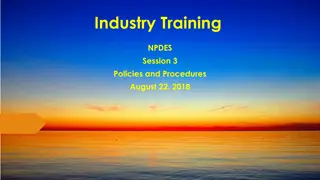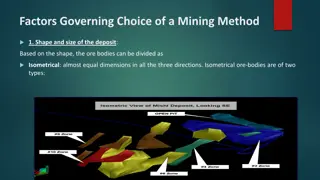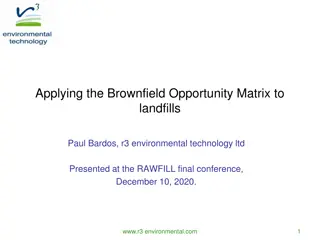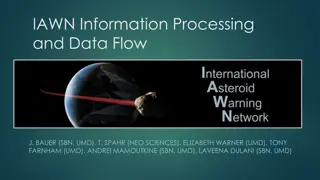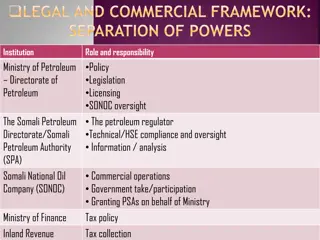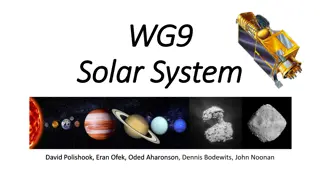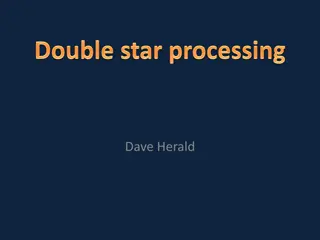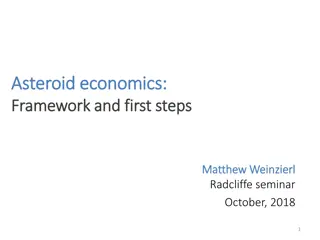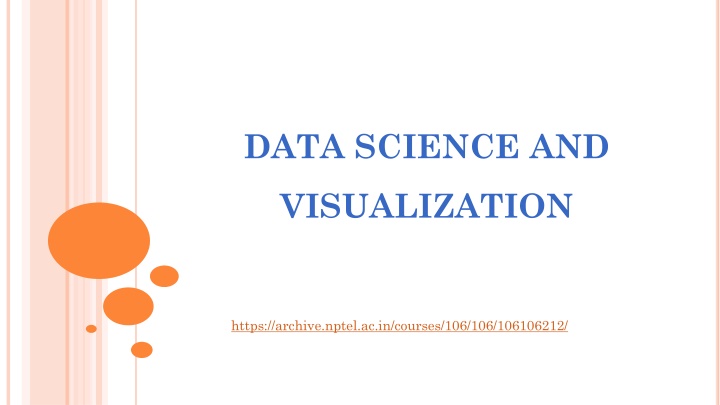
Legal Considerations in Asteroid and Space Mining Activity
This article explores the gaps within the Asteroid Act and examines terrestrial law sources that may fill those gaps in space commerce. It discusses the need for legal adaptations to accommodate emerging commercial activities in space like asteroid mining and space tourism, emphasizing the importance of aligning legal frameworks with international obligations.
Uploaded on | 0 Views
Download Presentation

Please find below an Image/Link to download the presentation.
The content on the website is provided AS IS for your information and personal use only. It may not be sold, licensed, or shared on other websites without obtaining consent from the author. If you encounter any issues during the download, it is possible that the publisher has removed the file from their server.
You are allowed to download the files provided on this website for personal or commercial use, subject to the condition that they are used lawfully. All files are the property of their respective owners.
The content on the website is provided AS IS for your information and personal use only. It may not be sold, licensed, or shared on other websites without obtaining consent from the author.
E N D
Presentation Transcript
DATA SCIENCE AND VISUALIZATION https://archive.nptel.ac.in/courses/106/106/106106212/
MODULE 1 INTRODUCTION TO DATA SCIENCE Introduction: What is Data Science? Big Data and Data Science hype Getting past the hype Why now? Datafication The current landscape Data science jobs A data science profile Thought Experiment: Meta-Definition OK, So What is Data Scientist, Really? In Academia, In Industry Needed Statistical Inference: Populations and samples, Statistical modelling, probability distributions, fitting a model
WHATIS DATA SCIENCE? Data Science is an approach of analyzing the past or current data and predicting the future outcomes with the aim of making well-versed decisions. Data science is an inter-disciplinary field that uses scientific methods, knowledge of mathematics and statistics, algorithms, programming skills to extract knowledge and insights from raw data.
BIG DATAAND DATA SCIENCE HYPE What is BigData anyway? What does datascience mean? What is the relationship between Big Data and data science? Is data science the science of Big Data? Is data science only the stuff going on in companies like Google and Facebook and tech companies? There s a distinct lack of respect for the researchers in academia and industry labs who have been working on this kind of stuff for years, and whose work is based on decades (in some cases, centuries) of work by statisticians, computer scientists, mathematicians, engineers, and scientists of all types The hype is crazy - Masters of the Universe - to describe data scientists In general, hype masks reality and increases the noise-to-signal ratio Statisticians already feel that they are studying and working on the Science of Data . Data science is not just a rebranding of statistics or machine learning but rather a field into itself Anything that has to call itself a science isn t a data science
GETTING PASTTHE HYPE It s a general truism that, whenever you go from school to a real job, you realize there s a gap between what you learned in school and what you do on the job. In other words, you were simply facing the difference between academic statistics and industry statistics. There s is a difference between industry and academia. But does it really have to be that way? Why do many courses in school have to be so intrinsically out of touch with reality? The general experience of data scientists is that, at their job, they have access to a larger body of knowledge and methodology Around all the hype, in other words, there is a ring of truth: this is something new. But at the same time, it s a fragile, nascent idea at real risk of being rejected prematurely Understanding the cultural phenomenon of data science and how others were experiencing it. Study how industry and universities are doing data science by meeting with people at Google, at startups and tech companies, and at universities
WHY NOW? Shopping, communicating, reading news, listening to music, searching for information, expressing our opinions all this is being tracked online What people might not know is that the datafication of our offline behavior has started as well, mirroring the online data collection revolution (more on this later) It s not just Internet data, though it s finance, the medical industry, pharmaceuticals, bioinformatics, social welfare, government, education, retail, and the list goes on. In some cases, the amount of data collected might be enough to be considered big in other cases, it s not. On the Internet, this means Amazon recommendation systems, friend recommendations on Facebook, film and music recommendations, and so on. In finance, this means credit ratings, trading algorithms, and models.
In education, this is starting to mean dynamic personalized learning and assess ments coming out of places like Knewton and Khan Academy. In government, this means policies based on data. Technology makes this possible: infrastructure for large-scale data processing, increased memory, and bandwidth, as well as a cultural acceptance of technology in the fabric of our lives. This wasn t true a decade ago. Consideration should be to the ethical and technical responsibilities for the people responsible for the process.
WHY DATA SCIENCE? Companies have been storing their data. Data has become the most abundant thing today. But, what will we do with this data? Let s take an example: Say, company which makes mobile phones, released their first product, became a massive hit. Its time to come up with something new, so as to meet the expectations of the users - eagerly waiting for next release. Here comes Data Science, apply various data mining techniques like sentiment analysis, knowledge of mathematical and statistical methods, scientific methods, algorithms, programming skills on user generated feedback and pick things what users are expecting in the next release and making well-versed decisions.
Thus, through Data Science we can make better decisions, we can reduce production costs by coming out with efficient ways, and give customers what they actually want! Thus, there are countless benefits that Data Science can result in, and hence it has become absolutely necessary for the company to have a Data Science Team. Data science making effective decision and development of data product
DATAFICATION Datafication is a process of taking all aspects of life and turning them into data. For example, Google s augmented-reality glasses datafy the gaze, Twitter datafies stray thoughts, LinkedIn datafies professional networks. Datafication is an interesting concept and led us to consider its importance with respect to people s intentions about sharing their own data. We are being datafied, or rather our actions are, and when we like someone or something online, we are intending to be datafied or at least we should expect to be. But when we merely browse the Web, we are unintentionally, or at least passively, being datafied through cookies that we might or might not be aware of. And when we walk around in a store, or even on the street, we are being datafied in a completely unintentional way, via sensors, cameras, or Google glasses.
Once we datafy things, we can transform their purpose and turn the information into new forms of value Who is we in that case? What kinds of value do they refer to? The we is the modelers and entrepreneurs making money from getting people to buy stuff, and The value translates into something like increased efficiency through automation. If we want to think bigger, if we want our we to refer to people in general, we ll be swimming against the tide.
THE CURRENT LANDSCAPE OF DATA SCIENCE Drew Conway s Venn diagram of data science from 2010, shown in Figure 1-1
In Drew Conways Venn Diagram of Data Science, data science is the intersection of 3 sectors Hacking skills Math and statistics knowledge and Substantive expertise It is known to everyone that data is the key part of data science. And data is a commodity traded electronically; so, in order to be in this market, one needs to speak hacker. So what does this line means? Being able to manage text files at the command-line, learning vectorized operations, thinking algorithmically; are the hacking skills that make for a successful data hacker.
Once you have collected and cleaned the data, the next step is to actually obtain insight from it. In order to do this, you need to use appropriate mathematical and statistical methods, that demand at least a baseline familiarity with these tools. This is not to say that a PhD in statistics is required to be a skilled data scientist, but it does need understanding what an ordinary least squares regression is and how to explain it. The third important part is Substantive expertise. According to Drew Conway, data plus math and statistics only gets you machine learning , which is excellent if that is what you are interested in, but not if you are doing data science. Science is about experimentation and building knowledge, which demands some motivating questions about the world and hypotheses that can be brought to data and tested with statistical methods.
On the other hand, substantive expertise + knowledge in mathematics and statistics are where maximum traditional researcher falls . Doctoral level researchers use most of their time getting expertise in these areas, but very little time acquiring technology. Part of this is the culture of academia, which does not compensate researchers for knowing technology. Finally, a name on the hacking skills + substantive expertise = danger zone . This is where he puts people who, know enough to be dangerous , and it is the most questionable area in the diagram. In this zone people who are supremely able of extracting and structuring data, probably associated with a field they know quite a bit about, and probably even know enough R to run a linear regression and report the coefficients.
but they require an understanding of what those coefficients mean. It is from this part of the diagram that the phrase lies, damned lies, and statistics arises, because either through ignorance or dislike this overlap of skills gives people the ability to create what appears to be a legal analysis without any understanding of how they got there or what they have created. Fortunately, it requires intentional ignorance to obtain hacking skills and substantive expertise without learning some math and statistics along the way.
DATA SCIENCE JOBS Job descriptions: They ask data scientists to be experts in computer science, statistics, communication, data visualization, and to have extensive domain expertise. Observation: Nobody is an expert in everything, which is why it makes more sense to create teams of people who have different profiles and different expertise together, as a team, they can specialize in all those things.
A DATA SCIENCE PROFILE Skill levels in the following domains: Computer science Math Statistics Machine learning Domain expertise Communication and presentation skills Data visualization
OK, SO WHAT ISA DATA SCIENTIST, REALLY? IN ACADEMIA an academic data scientist is a scientist, trained in anything from social science to biology, who works with large amounts of data, and must grapple with computational problems posed by the structure, size, messiness, and the complexity and nature of the data, while simultaneously solving a real-world problem across academic disciplines, the computational and deep data problems have major commonalities. If researchers across departments join forces, they can solve multiple real-world problems from different domains.
IN INDUSTRY What do data scientists look like in industry? It depends on the level of seniority and whether you re talking about the Internet/online industry in particular. The role of data scientist need not be exclusive to the tech world, but that s where the term originated. A data scientist is someone who knows how to extract meaning from and interpret data, which requires both tools and methods from statistics and machine learning, as well as being human. They spends a lot of time in the process of collecting, cleaning, and munging data, because data is never clean. This process requires persistence, statistics, and software engineering skills skills that are also necessary for understanding biases in the data, and for debugging logging output from code.
Once they gets the data into shape, a crucial part is exploratory data analysis, which combines visualization and data sense. Find patterns, build models, and algorithms some with the intention of understanding product usage and the overall health of the product, and others to serve as prototypes that ultimately get baked back into the product. They may design experiments, and they are a critical part of data-driven decision making. They ll communicate with team members, engineers, and leadership in clear language and with data visualizations so that even if others are not immersed in the data themselves, they will understand the implications.
STATISTICAL THINKINGINTHE AGEOF BIG DATA When you re developing your skill set as a data scientist, certain foundational pieces need to be in place first statistics, linear algebra and some programming. Even once you have those pieces, part of the challenge is that you will be developing several skill sets in parallel simultaneously data preparation and munging, modeling, coding, visualization, and communication that are interdependent. In the age of Big Data, classical statistics methods need to be revisited and reimagined in new contexts.
STATISTICAL INFERENCE The world we live in is complex, random, and uncertain. At the same time, it s one big data-generating machine. Data represents the traces of the real-world processes, and exactly which traces we gather are decided by our data collection or sampling method. You, the data scientist, the observer, are turning the world into data, and this is an utterly subjective, not objective, process. After separating the process from the data collection, we can see clearly that there are two sources of randomness and uncertainty. Namely, the randomness and uncertainty underlying the process itself, and the uncertainty associated with your underlying data collection methods
Once you have all this data, you have somehow captured the world, or certain traces of the world. But you can t go walking around with a huge Excel spreadsheet or database of millions of transactions and look at it and, with a snap of a finger, understand the world and process that generated it. So you need a new idea, and that s to simplify those captured traces into something more comprehensible, to something that somehow captures it all in a much more concise way, and that something could be mathematical models or functions of the data, known as statistical estimators. This overall process of going from the world to the data, and then from the data back to the world, is the field of statistical inference.
Statistical inference is the discipline that concerns itself with the development of procedures, methods, and theorems that allow us to extract meaning and information from data that has been generated by stochastic (random) processes.
POPULATIONS AND SAMPLES POPULATIONS In statistical inference population isn t used to simply describe only people. It could be any set of objects or units, such as tweets or photographs or stars. If we could measure the characteristics or extract characteristics of all those objects, we d have a complete set of observations, and the convention is to use N to represent the total number of observations in the population Suppose your population was all emails sent last year by employees at a huge corporation, BigCorp. Then a single observation could be a list of things: the sender s name, the list of recipients, date sent, text of email, number of characters in the email, number of sentences in the email, number of verbs in the email, and the length of time until first reply
SAMPLES When we take a sample, we take a subset of the units of size n in order to examine the observations to draw conclusions and make inferences about the population. There are different ways you might go about getting this subset of data, and you want to be aware of this sampling mechanism because it can introduce biases into the data, and distort it, so that the subset is not a mini-me shrunk-down version of the population. Once that happens, any conclusions you draw will simply be wrong and distorted. In the BigCorp email example, you could make a list of all the employees and select 1/10th of those people at random and take all the email they ever sent, and that would be your sample. Alternatively, you could sample 1/10th of all email sent each day at random, and that would be your sample. Both these methods are reasonable, and both methods yield the same sample size. But if you took them and counted how many email messages each person sent, and used that to estimate the underlying distribution of emails sent by all indiviuals at BigCorp, you might get entirely different answers.
POPULATIONSAND SAMPLESOF BIG DATA Sampling solves some engineering challenge In the current popular discussion of Big Data, the focus on enterprise solutions such as Hadoop to handle engineering and computational challenges caused by too much data overlooks sampling as a legitimate solution. At Google, for example, software engineers, data scientists, and statisticians sample all the time. How much data you need at hand really depends on what your goal is: for analysis or inference purposes, you typically don t need to store all the data all the time. On the other hand, for serving purposes you might: in order to render the correct information in a UI for a user, you need to have all the information for that particular user.
Bias Even if we have access to all of Facebook s or Google s or Twitter s data corpus, any inferences we make from that data should not be extended to draw conclusions about humans beyond those sets of users, or even those users for any particular day New kinds of data Gone are the days when data is just a bunch of numbers and categorical variables. A strong data scientist needs to be versatile and comfortable with dealing a variety of types of data, including: Traditional: numerical, categorical, or binary Text: emails, tweets, New York Times articles Records: user-level data, timestamped event data, json-formatted log files Geo-based location data: briefly touched on in this chapter with NYC housing data Network Sensor data Images These new kinds of data require us to think more carefully about what sampling means in these contexts.
BIG DATA CAN MEAN BIG ASSUMPTIONS The Big Data revolution consists of three things: Collecting and using a lot of data rather than small samples Accepting messiness in your data Giving up on knowing the causes The new approach of Big Data is letting N=ALL. Can N=ALL? the assumption we make that N=ALL is one of the biggest problems we face in the age of Big Data. It is, above all, a way of excluding the voices of people who don t have the time, energy, or access to cast their vote in all sorts of informal, possibly unannounced, elections. the recommendations you receive on Netflix don t seem very good because most of the people who bother to rate things on Netflix are young and might have different tastes than you, which skews the recommendation engine toward them.
Data is not objective Another way in which the assumption that N=ALL can matter is that it often gets translated into the idea that data is objective. It is wrong to believe either that data is objective or that dataspeaks, and beware of people who say otherwise. At one point, a data scientist is quoted as saying, Let s put everything in and let the data speak for itself. Tries to find diamond in the rough types of people to hire. A worthy effort, but one that you have to think through. ignoring causation can be a flaw, rather than a feature. Models that ignore causation can add to historical problems instead of addressing them. And data doesn t speak for itself. Data is just a quantitative, pale echo of the events of our society.
n = 1 At the other end of the spectrum from N=ALL, we have n=1, by which we mean a sample size of 1. In the old days a sample size of 1 would be ridiculous; you would never want to draw inferences about an entire population by looking at a single individual. But the concept of n=1 takes on new meaning in the age of Big Data, where for a single person, we actually can record tons of information about them, and in fact we might even sample from all the events or actions they took (for example, phone calls or keystrokes) in order to make inferences about them.
MODELING What is a model? Architects capture attributes of buildings through Statistical blueprints and three- dimensional, scaled-down versions. Molecular biologists capture protein structure with three-dimensional visualizations of the connections between amino acids. Statisticians and data scientists capture the uncertainty and randomness of data-generating processes with mathematical functions that express the shape and structure of the data itself. A model is our attempt to understand and represent the nature of reality through a particular lens, be it architectural, biological, or mathematical.
A model is an artificial construction where all extraneous detail has been removed or abstracted. Attention must always be paid to these abstracted details after a model has been analyzed to see what might have been overlooked. Statistical modelling Before you get too involved with the data and start coding, it s useful to draw a picture of what you think the underlying process might be with your model. What comes first? What influences what? What causes what? What s a test of that? But different people think in different ways. Some prefer to express these kinds of relationships in terms of math. The mathematical expressions will be general enough that they have to include parameters, but the values of these parameters are not yet known.
In mathematical expressions, the convention is to use Greek letters for parameters and Latin letters for data. So, for example, if you have two columns of data, x and y, and you think there s a linear relationship, you d write down y = 0 + 1x. You don t know what 0 and 1 are in terms of actual numbers yet, so they re the parameters. Other people prefer pictures and will first draw a diagram of data flow, possibly with arrows, showing how things affect other things or what happens over time. This gives them an abstract picture of the relationships before choosing equations to express them.
How do you build a model? One place to start is Exploratory Data Analysis (EDA). This entails making plots and building intuition for your particular dataset. EDA helps out a lot, as well as trial and error and iteration. The best thing to do is start simply and then build in complexity. Do the dumbest thing you can think of first. It s probably not that dumb. For example, you can (and should) plot histograms and look at scatterplots to start getting a feel for the data. Then you just try writing something down, even if it s wrong first. So try writing down a linear function. When you write it down, you force yourself to think: does this make any sense? If not, why? What would make more sense? You start simply and keep building it up in complexity, making assumptions, and writing your assumptions down
Simple model gets you 90% of the way there and only takes a few hours to build and fit, whereas getting a more complex model might take months and only get you to 92%. Some of the building blocks of these models are probability distributions. Probability distributions Probability distributions are the foundation of statistical models. One can take multiple semesters of courses on probability theory, and so it s a tall challenge to condense it down for you in a small section. The classical example is the height of humans, following a normal distribution a bell-shaped curve, also called a Gaussian distribution, named after Gauss. Other common shapes have been named after their observers as well (e.g., the Poisson distribution and the Weibull distribution), while other shapes such as Gamma distributions or exponential distributions are named after associated mathematical objects.
Figure 2-1 as an illustration of the various common shapes, and to remind you that they only have names because someone observed them enough times to think they deserved names. There is actually an infinite number of possible distributions. They are to be interpreted as assigning a probability to a subset of possible outcomes, and have corresponding functions. For example, the normal distribution is written as: The parameter is the mean and median and controls where the distribution is centered, and the parameter controls how spread out the distribution is. This is the general functional form, but for specific real-world phenomenon, these parameters have actual numbers as values, which we can estimate from the data. A standard deviation (or ) is a measure of how dispersed the data is in relation to the mean.
Random variable A random variable denoted by x or y can be assumed to have a corresponding probability distribution, p(x) , which maps x to a positive real number. In order to be a probability density function, we re restricted to the set of functions such that if we integrate p(x) to get the area under the curve, it is 1, so it can be interpreted as probability. For example, let x be the amount of time until the next bus arrives. x is a random variable because there is variation and uncertainty in the amount of time until the next bus. Suppose we know (for the sake of argument) that the time until the next bus has a probability density function of . If we want to know the likelihood of the next bus arriving in between 12 and 13 minutes, then we find the area under the curve between 12 and 13 by
How do we know this is the right distribution to use? Well, there are two possible ways: we can conduct an experiment where we show up at the bus stop at a random time, measure how much time until the next bus, and repeat this experiment over and over again. Then we look at the measurements, plot them, and approximate the function as discussed. Or, because we are familiar with the fact that waitingtime is a common enough real-world phenomenon that a distribution called the exponential distribution has been invented to describe it. In addition to denoting distributions of single random variables with functions of one variable, we use multivariate functions called joint distributions to do the same thing for more than one random variable.
So in the case of two random variables, for example, we could denote our distribution by a function p(x, y) , and it would take values in the plane and give us nonnegative values. In keeping with its interpretation as a probability, its (double) integral over the whole plane would be 1. We also have what is called a conditional distribution, p(x|y) , which is to be interpreted as the density function of x given a particular value of y. When we re working with data, conditioning corresponds to subsetting. So for example, suppose we have a set of user-level data for Amazon.com that lists for each user the amount of money spent last month on Amazon, whether the user is male or female, and how many items they looked at before adding the first item to the shopping cart.
If we consider X to be the random variable that represents the amount of money spent, then we can look at the distribution of money spent across all users, and represent it as p(X) . We can then take the subset of users who looked at more than five items before buying anything, and look at the distribution of money spent among these users. Let Y be the random variable that represents number of items looked at, then p (X, Y) > 5 would be the corresponding conditional distribution. A conditional distribution has the same properties as a regular distribution in that when we integrate it, it sums to 1 and has to take nonnegative values.
FITTINGAMODEL Fitting a model Fitting a model means that you estimate the parameters of the model using the observed data. Approximate the real-world mathematical process that generated the data. Fitting the model often involves optimization methods and algorithms, such as maximum likelihood estimation, to help get the parameters. When you estimate the parameters, they are actually estimators, meaning they themselves are functions of the data. Once you fit the model, you actually can write it as y =7.2+4.5x, for example, which means that your best guess is that this equation or functional form expresses the relationship between your two variables, based on your assumption that the data followed a linear pattern.
Fitting the model is when you start actually coding: your code will read in the data, and you ll specify the functional form that you wrote down on the piece of paper. Then R or Python will use built-in optimization methods to give you the most likely values of the parameters given the data. Overfitting Overfitting is the term used to mean that you used a dataset to estimate the parameters of your model, but your model isn t that good at capturing reality beyond your sampled data. You might know this because you have tried to use it to predict labels for another set of data that you didn t use to fit the model, and it doesn t do a good job, as measured by an evaluation metric such as accuracy.




